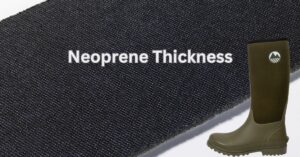Wellington Boot Care & Cleaning
Unravel the intricacies of what makes a wellington boot tick! This section delves into the various materials for crafting these durable, waterproof staples. Whether you’re curious about the traditional rubber origins, the evolution to modern-day PVC, or the sustainability aspects, we’ve got the answers. Discover the science and reasoning behind the material choices of your favourite wellies right here.
WELLINGTON BOOT MATERIALS FAQ
Natural rubber, derived from the sap of the rubber tree (Hevea brasiliensis), has long been a favored material for wellington boots—and for good reason.
Elasticity & Flexibility: One of the hallmark properties of natural rubber is its high elasticity. This means that wellington boots made from this material can easily stretch to accommodate the foot and then return to their original shape. This elastic nature ensures a snug fit while allowing for flexibility in movement.
Durability: Boots need to withstand rough terrains, mud, water, and regular wear and tear. Natural rubber possesses high tensile strength, ensuring that wellies made from it can endure these challenges for a long time without falling apart.
Waterproofing: Given that one of the main purposes of wellington boots is to keep feet dry, the natural water-resistant properties of rubber make it an ideal choice. It acts as an impermeable barrier, ensuring that water doesn’t seep through.
Comfort: Natural rubber, being a soft and flexible material, contours well to the foot. This ensures a level of comfort, especially when one needs to wear the boots for extended periods.
Gripping Capabilities: The natural texture of rubber provides a good grip, reducing the likelihood of slipping in wet or muddy conditions. This is crucial for activities like farming or hiking in wet environments.
Environmentally-Friendly: While the rubber extraction process needs to be managed sustainably, natural rubber is a renewable resource. Trees can be tapped for rubber multiple times, and once they’re past their productive age, they can be replaced. This contrasts with synthetic materials derived from non-renewable petroleum sources.
Synthetic rubber, as opposed to natural rubber derived from rubber trees, is made using various petroleum-based monomers. Over the decades, advancements in polymer science have brought forth multiple types of synthetic rubber, each with its unique properties. Here’s why synthetic rubber has found its place in the manufacture of wellington boots:
Consistency in Production: Unlike natural rubber, which can be affected by environmental factors and diseases in rubber trees, synthetic rubber can be consistently produced in large quantities. This ensures a stable supply and predictable quality.
Tailored Properties: One significant advantage of synthetic rubber is the ability to engineer and modify it to have specific desired properties. Depending on the requirements, it can be made to be more resistant to chemicals, oils, or abrasions.
Durability: Certain types of synthetic rubber can offer enhanced durability and wear resistance. This makes the boots last longer, even in tougher conditions.
Cost-Effective: Sometimes, synthetic rubber can be more cost-effective than natural rubber, especially when there are fluctuations in the prices or availability of natural rubber.
Waterproofing: Just like natural rubber, synthetic versions also provide excellent waterproofing qualities, making them ideal for the primary purpose of wellington boots.
Temperature Resilience: Some synthetic rubbers can be formulated to remain flexible in colder temperatures, where natural rubber might become more brittle. This makes them particularly suitable for wellington boots used in colder climates.
Eco-friendly Alternatives: With growing concerns about the environment, there are now emerging varieties of bio-based synthetic rubbers made from renewable resources, offering a more sustainable option than traditional petroleum-based rubbers.
Neoprene, also known by its technical name polychloroprene, is a synthetic rubber that has garnered attention in various industries for its exceptional qualities. Initially developed as an oil-resistant substitute for natural rubber, neoprene soon found its way into the world of wellington boots. Here’s why:
Insulation: One of the standout properties of neoprene is its excellent insulating capability. Wellington boots with a neoprene lining or made predominantly from the material provide superior warmth, making them ideal for colder climates or conditions. This is the same reason neoprene is used in wetsuits for diving.
Waterproofing: Neoprene is inherently waterproof, ensuring that feet remain dry, aligning with the fundamental purpose of wellington boots.
Flexibility: Neoprene exhibits flexibility over a wide range of temperatures, ensuring the boots remain comfortable and easy to move in, whether it’s a cold winter morning or a warmer spring day.
Durability: The material is resilient against degradation from sunlight, ozone, and weather, ensuring a long lifespan for the boots.
Cushioning & Comfort: Neoprene has a soft texture, offering a cushioned feel underfoot, enhancing the comfort level of wellington boots.
Chemical Resistance: Neoprene is resistant to a range of chemicals, making it suitable for environments where accidental spills or exposures might occur.
Enhanced Fit: The malleable nature of neoprene ensures a snug fit, reducing the chances of blisters or discomfort, especially when worn for extended periods.
Polyvinyl chloride, commonly known as PVC, is a versatile plastic material that has found applications in various industries, including the footwear sector. Here’s an analysis of the pros and cons of using PVC in the construction of wellington boots:
Pros:
Cost-Effective: One of the primary reasons manufacturers opt for PVC is its affordability. Boots made from PVC tend to be more budget-friendly than those made from natural rubber or other materials.
Waterproof: PVC is naturally water-resistant, making it ideal for the primary requirement of wellington boots—to keep feet dry.
Chemical Resistance: PVC boots often showcase resistance against various chemicals, making them suitable for specific industries where accidental chemical spills are a concern.
Durability: In general, PVC offers a reasonable level of durability against wear and tear, ensuring that the boots serve their purpose for a decent duration.
Easy to Clean: The smooth surface of PVC boots makes them easy to wipe down and clean, an essential feature for boots often exposed to mud and muck.
Cons:
Environmental Concerns: PVC production and disposal raise environmental issues. When burned, PVC can release dioxins, which are harmful pollutants. Additionally, PVC isn’t biodegradable.
Less Breathability: PVC doesn’t offer as much breathability as some other materials. This can lead to sweaty feet and reduced comfort during prolonged wear.
Rigidity in Cold Temperatures: PVC can become less flexible and more brittle in colder conditions, which may reduce comfort and potentially affect the boot’s durability.
Potential Chemical Leaching: Some PVC products have been found to leach harmful chemicals, like phthalates, which can be a health concern. It’s essential to ensure that any PVC boots conform to safety standards.
Lesser Comfort: While some PVC boots may incorporate comfort features, on a general scale, they might not offer the same level of cushioning or ergonomic design as some more premium materials.
Wellieboots.com NEWSLETTER
Sign up to get the latest reviews, news, tips and where to get the best wellie deals!
You will only get emails from wellieboots.com (no 3rd parties)
We generally send one email per month





